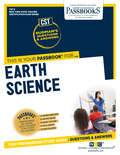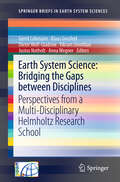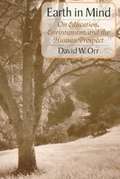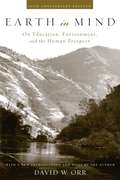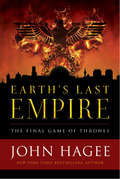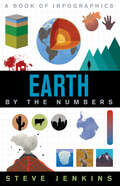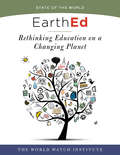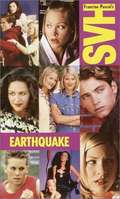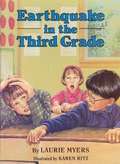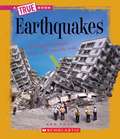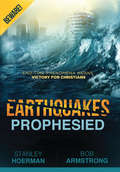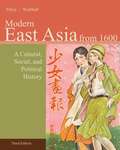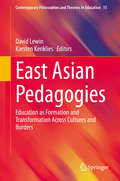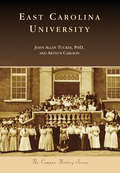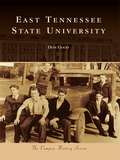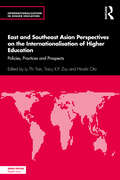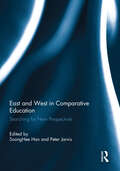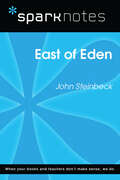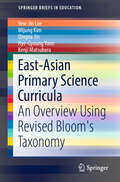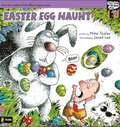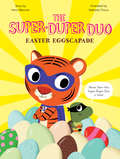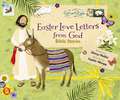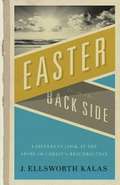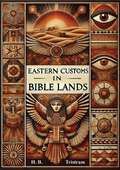- Table View
- List View
Earth Science: Passbooks Study Guide (New York State Teacher Certification Examination Series (NYSTCE))
by National Learning CorporationThe New York State Teacher Certification Exams (NYSTCE) are required for all candidates seeking licensure in the State. The NYSTCE series consists of many different tests assessing skills and abilities necessary for teachers. The Passbook® for the Content Specialty Test in Earth Science provides hundreds of multiple-choice questions in the areas that will likely be covered on your upcoming certification exam, including but not limited to: gathering and interpreting data; earth and space systems; the solar system; weather and climate; geology; and other related areas.
Earth System Science: Bridging the Gaps between Disciplines
by Klaus Grosfeld Anna Wegner Vikram Unnithan Dieter Wolf-Gladrow Justus Notholt Gerrit LohmannEarth system science is traditionally split into various disciplines (Geology, Physics, Meteorology, Oceanography, Biology etc.) and several sub-disciplines. Overall, the diversity of expertise provides a solid base for interdisciplinary research. However, gaining holistic insights into the Earth system requires the integration of observations, paleoclimate data, analysis tools and modeling. These different approaches of Earth system science are rooted in various disciplines that cut across a broad range of timescales. It is, therefore, necessary to link these disciplines at a relatively early stage in PhD programs. The linking of 'data and modeling', as it is the special emphasis in our graduate school, enables graduate students from a variety of disciplines to cooperate and exchange views on the common theme of Earth system science, which leads to a better understanding of processes within a global context.
Earth in Mind: On Education, Environment, and the Human Prospect
by David W. OrrOrr (environmental studies and politics, Oberlin College) presents the tenth anniversary edition of his text addressing educational reform from an environmental perspective. In a collection of 23 essays, written for various purposes and audiences between 1990 and 1993, Orr argues that, where educational debates about standards and reforms have centered around preparing students to compete in a global economy, an equally important concern should be teaching students the ecological context in which humans live, to develop in them an ethical view of the world and their obligations to it. The tenth edition includes a brief new introduction and a new final chapter offering "hope in hard times. " Annotation ©2004 Book News, Inc. , Portland, OR (booknews. com)
Earth in Mind: On Education, Environment, and the Human Prospect
by David W. OrrIn Earth in Mind, noted environmental educator David W. Orr focuses not on problems in education, but on the problem of education.Much of what has gone wrong with the world, he argues, is the result of inadequate and misdirected education that: alienates us from life in the name of human domination; causes students to worry about how to make a living before they know who they are; overemphasizes success and careers; separates feeling from intellect and the practical from the theoretical; deadens the sense of wonder for the created world.The crisis we face, Orr explains, is one of mind, perception, and values. It is, first and foremost, an educational challenge.The author begins by establishing the grounds for a debate about education and knowledge. He describes the problems of education from an ecological perspective, and challenges the "terrible simplifiers" who wish to substitute numbers for values. He follows with a presentation of principles for re-creating education in the broadest way possible, discussing topics such as biophilia, the disciplinary structure of knowledge, the architecture of educational buildings, and the idea of ecological intelligence. Orr concludes by presenting concrete proposals for reorganizing the curriculum to draw out our affinity for life.
Earth's Last Empire: The Final Game of Thrones
by John HageeBible prophecy clearly reveals that immediately prior to the rapture of the Church, four powerful kings will race onto the stage of world history. Pastor Hagee reveals who they are, where they come from, and what they signify. Learn why Hagee believes that we are in the beginning stages of World War III, and how this will eventually take us to the Battle of Armageddon. Pastor Hagee vividly describes the key players that signify the King is coming!
Earth: By The Numbers (By the Numbers)
by Steve JenkinsCaldecott Honor winner Steve Jenkins introduces By the Numbers infographic readers chock full of incredible infographs and stunning, full-color cut-paper illustrations. Earth will focus on the fascinating ins-and-outs of earth science.Through infographics, illustrations, facts, and figures, readers will learn about the complex and wonderful place we call home, Earth. Discover some of the most fascinating aspects of our planet through astonishing numbers: the stretch of time from Earth's formation to the present, the misleading way the surface area of a continent can appear on a map, the angle of Earth's axis that creates the seasons, what percentage of Earth's land is covered in deserts or forests or cities, and so much more. With his signature style, Steve Jenkins explores the most fascinating fields of natural science.
EarthEd: Rethinking Education on a Changing Planet (State of the World)
by The Worldwatch InstituteEarth education is traditionally confined to specific topics: ecoliteracy, outdoor education, environmental science. But in the coming century, on track to be the warmest in human history, every aspect of human life will be affected by our changing planet. Emerging diseases, food shortages, drought, and waterlogged cities are just some of the unprecedented challenges that today's students will face. How do we prepare 9.5 billion people for life in the Anthropocene, to thrive in this uncharted and more chaotic future?Answers are being developed in universities, preschools, professional schools, and even prisons around the world. In the latest volume of State of the World, a diverse group of education experts share innovative approaches to teaching and learning in a new era. Topics include systems thinking for kids; the importance of play in early education; social emotional learning; comprehensive sexuality education; indigenous knowledge; sustainable business; medical training to treat the whole person; teaching law in the Anthropocene; and more.EarthEd addresses schooling at all levels of development, from preschool to professional. Its lessons can inform teachers, policy makers, school administrators, community leaders, parents, and students alike. And its vision will inspire anyone who wants to prepare students not only for the storms ahead but to become the next generation of sustainability leaders.
Earthquake (Sweet Valley High Super Edition #11)
by Francine PascalThe earthquake destroyed Sweet Valley. . . and one of the twins' best friends is dead. . . . Twin sisters Jessica and Elizabeth Wakefield have been ripped apart in the chaos following a devastating earthquake. Through the agony, fear, and despair, they must dig through the rubble to find each other again, hoping against hope that they haven't been separated for good. But as they search, tragedy surrounds them. Enid Rollins clings to life by a thread as Devon Whitelaw and Bruce Patman work to save her. Steven Wakefield risks his life to help his one true love. Most frightening of all, Todd Wilkins, Lila Fowler, Ken Matthews, and Olivia Davidson are missing and presumed dead. Can their friends find them before it's too late?
Earthquake in the Third Grade
by Karen RitzJust as the ants feel a jolt when John knocks over the ant farm, John and his third grade classmates find their world turned upside down following the news of their beloved teacher's imminent departure.
Earthquakes
by Ker ThanWhat makes the earth quake, rivers flood, and volcanoes blow their tops? How do natural forces become natural disasters? Buckle your seatbelts and get ready for a bumpy ride to the center of the earth for a look at some of the wildest phenomena in the history of earth science!
Earthquakes Prophesied: Beware!
by Stanley Hoerman Bob ArmstrongThroughout history, God has used earthquakes to prove His presence, deliver His people, execute His wrath, or demonstrate His power. In the future, the Bible says, earthquakes will also punctuate significant happenings set for the last days. The writings of more than two dozen individuals in church history who have prophesied specific earthquakes for the end times are compiled in this book by Stanley Hoerman and Bob Armstrong. Included are the prophecies of St. Hildegard from the twelfth century, Mother Shipton from the sixteenth century, William Branham from the twentieth century, and current Christians such as Jim Bakker. This trumpet call for believers to &“get ready&” for the end times offers a historical thread of prophetic expressions, each pointing us toward dramatic seismic events to come at the end of the age.
East Asia: A Cultural, Social, and Political History, Volume II: From 1600
by Patricia Buckley Ebrey Anne WalthallWritten by top scholars in the field, EAST ASIA: A CULTURAL, SOCIAL, AND POLITICAL HISTORY, VOLUME II: FROM 1600, 3E delivers a comprehensive cultural, political, economic, and intellectual history of East Asia, while focusing on the narratives and histories of China, Japan, and Korea in a larger, global context. Full color inserts on such topics as food, clothing, and art objects illustrate the rich artistic heritage of East Asia. A range of primary source documents spotlights women's independence, students-turned-soldiers, and other stirring issues, while intriguing biographical sketches throughout highlight the lives of popular figures and ordinary people alike.
East Asian Pedagogies: Education as Formation and Transformation Across Cultures and Borders (Contemporary Philosophies and Theories in Education #15)
by David Lewin Karsten KenkliesThis book opens up philosophical spaces for comparative discussions of education across ‘East and West’. It develops an intercultural dialogue by exploring the Anglo-American traditions of educational trans-/formation and European constructions of Bildung, alongside East Asian traditions of trans-/formation and development. Comparatively little research has been done in this area, and many questions concerning the commensurability of North American, European and East Asian pedagogies remain. Despite this dearth of theoretical research, there is ample evidence of continued interest in (self-)formation through various East Asian practices, from martial arts to health and spiritual practices (e.g. Aikido, Tai Chi, Yoga, mindfulness etc.), suggesting that these ‘traditional’ practices and pedagogical relations have something important to offer, despite their marginal standing in educational discourse. This book will appeal to all researchers and students of comparative education studies with an interest in issues of interpretation and translation between different traditions and cultures.
East Carolina University
by John Allen Tucker Arthur CarlsonEast Carolina University was founded by the State of North Carolina in 1907 as a teacher training school meant to provide professionally trained faculty for schools in the eastern part of the state. Within two decades, the school matured into a teacher's college. Although coeducational from the start, the vast majority of the student body early on was female. Following World War II and the gender transformation of higher education resulting from successive GI Bills, East Carolina emerged with increasing balance as the male student body grew to match the female population on campus. In subsequent decades, East Carolina continued to expand academically, emerging as a research university with a medical school and a dental school. Today, ECU is a leading producer of K-12 teachers in the Southeast as well as a leader nationwide in training practitioners of family medicine. The impressive development of East Carolina has flowed from its embodiment of the school's ethic of service to the local community and, in the broadest context, the best interests of humanity.
East Tennessee State University
by Don GoodEast Tennessee State University (ETSU), located in Johnson City, was founded in 1911 as East Tennessee State Normal School to provide teachers for the state's public schools. The institution originally offered two courses of study: a four-year high school program and a two-year normal school curriculum, which initially enrolled 29 students. Today ETSU serves more than 14,000 students and offers over 100 undergraduate programs, 75 master's programs, and a dozen areas of doctoral study. The university is organized into 11 colleges and schools. Approximately 700 full-time faculty members, 80 percent of whom hold doctorates, serve the institution's students. Indicative of embracing its Appalachian heritage and location, the university boasts several unique programs, which include bluegrass studies and storytelling. While ETSU offers all the opportunities and resources of any large university, it also has many advantages typically found only in small colleges.
East and Southeast Asian Perspectives on the Internationalisation of Higher Education: Policies, Practices and Prospects (Internationalization in Higher Education Series)
by Ly Thi Tran Zou, Tracy X.P. Hiroshi OtaThis book provides robust insights into the current policies, trends, challenges and possibilities in the internationalisation of higher education in East and Southeast Asian countries, revealing emergent and new models and practices in this area, and discussing implications for mutual learning across different education systems. Drawing on case studies from Laos, Malaysia, Indonesia, Vietnam, South Korea, Guangdong–Hong Kong–Macao Greater Bay Area (GBA) and other parts of China, Singapore, the Philippines, Thailand and Japan, this volume addresses emergent and less-heard perspectives on and experiences in the internationalisation of higher education. By detailing, comparing and contrasting the key aspects of internationalisation across countries in Asia and the West, it discusses the implications for mutual learning across different higher education systems. Through practical case studies, this book brings to light the voices and experiences of researchers, who are studying core and new issues, opportunities and challenges facing the internationalisation of higher education in East and Southeast Asia. East and Southeast Asian Perspectives on the Internationalisation of Higher Education is a must-read text for practitioners, international education policy makers and advisors at the national and institutional levels. It will also be of interest to academics, researchers, administrators, students of international and comparative education courses, as well as anyone researching the internationalisation of higher education or looking to learn more about what internationalisation could look like in the future.
East and West in Comparative Education: Searching for New Perspectives
by SoongHee Han and Peter JarvisSparked by global capitalism’s demand for new knowledge and new commodities, as well as new logistical systems to deliver them, the nature of education has changed significantly. Universities, in striving to become a part of this knowledge society, have focused on responding to these demands, at the expense of the humanities and social sciences. The dominance of this way of thinking, primarily a product of Western educational thought, has clearly affected approaches to education in the East. The originalities, authenticities, and unique perspectives of the East have failed to get enough attention, subsumed by the focus on science and technology. However many education systems are still endeavouring to capture some of the indigenous and authentic culture of their home countries, incorporating national cultural ideals, even in subjects with a primarily vocational focus. Although the drive for scientific knowledge has led to a degree of standardisation and convergence, cultural differences still play a role in the education theory and policy of different countries.This book examines these cultural differences between different East Asian and South Asian countries, with chapters ranging from historical educational analysis to contemporary re-interpretations of the construction of society and education in the East. This book was originally published as a special issue of Comparative Education.
East of Eden (SparkNotes Literature Guide Series)
by SparkNotesEast of Eden (SparkNotes Literature Guide) by John Steinbeck Making the reading experience fun! Created by Harvard students for students everywhere, SparkNotes is a new breed of study guide: smarter, better, faster.Geared to what today's students need to know, SparkNotes provides:chapter-by-chapter analysis explanations of key themes, motifs, and symbols a review quiz and essay topics Lively and accessible, these guides are perfect for late-night studying and writing papers.
East-Asian Primary Science Curricula
by Mijung Kim Yew-Jin Lee Qingna Jin Hye-Gyoung Yoon Kenji MatsubaraThis book describes a comparative study of the primary science learning objectives (from the cognitive domain) in the curriculum of six high-achieving East Asian states -- mainland China, Hong Kong, Taiwan, Korea, Japan and Singapore. Specifically, the authors use one of the most widely accepted and useful tools in curriculum research -- revised Bloom's Taxonomy. This is the first time that such findings from all six states have been published in one place and the results are valuable for policymakers, educators and researchers around the globe. Our new English translations of the primary science learning objectives in China, Taiwan and Korea will also greatly facilitate future analyses of these curricula.
East-Asian Primary Science Curricula: An Overview Using Revised Bloom's Taxonomy (SpringerBriefs in Education)
by Mijung Kim Yew-Jin Lee Qingna Jin Hye-Gyoung Yoon Kenji MatsubaraThis book describes a comparative study of the primary science learning objectives (from the cognitive domain) in the curriculum of six high-achieving East Asian states — mainland China, Hong Kong, Taiwan, Korea, Japan and Singapore. Specifically, the authors use one of the most widely accepted and useful tools in curriculum research — revised Bloom’s Taxonomy. This is the first time that such findings from all six states have been published in one place and the results are valuable for policymakers, educators and researchers around the globe. Our new English translations of the primary science learning objectives in China, Taiwan and Korea will also greatly facilitate future analyses of these curricula.
Easter Egg Haunt (Tales from the Back Pew)
by Mike ThalerWith hilarious stories and nutty pictures, the Tales from the Back Pew series offers kid’s a unique view of church. Enjoy plenty of giggles with your child—and learn fun, important truths about God, church, and the Bible. It’s Easter. Will the Easter bunny be ten feet tall? Will it really lay eggs? I hope they’re not scrambled!
Easter Eggscapade (The Super-Duper Duo)
by Henri Meunier Nathalie ChouxRory and Sheldon are just regular guys—going to school, having play dates, and, of course, searching for chocolate Easter eggs. But when their bird neighbors' real eggs go missing, Rory and Sheldon spring into action to save the chicks—when they become the Super-Duper Duo! They use their super-duper powers—and their knowledge about cuckoo bird behavior—to find the culprit and return the baby birds to their nests. The Super-Duper Duo books mix zany adventure comics and animal facts in exciting young readers that are both fun and informative. Just another mission accomplished for the Super-Duper Duo!
Easter Love Letters from God: Bible Stories (Love Letters from God)
by Glenys NellistAre you looking for a way to teach your child about Holy Week and Easter? What if your child could also receive, open, and read his or her own personal mail from God to make the lessons come alive? Easter Love Letters from God contains seven beautifully illustrated Bible stories, each accompanied by a special Bible verse and an encouraging letter tucked away in its own lift-the-flap envelope that can be personalized to your child.Easter Love Letters from God is part of the Love Letters from God series written by Glenys Nellist. Unique features include:7 letters from God on a pull-out page enclosed inside an envelope, with space to write your child&’s name on each letterEndearing text that applies each Easter story directly to your child&’s life and helps grow their faithGorgeous, bright illustrations by Sophie AllsoppThe wonderous stories leading up to Jesus&’s resurrection on Easter SundayThis interactive picture book is perfect for ages 4-8 and is great for Easter baskets or as an addition to your child&’s home library.Check out other titles from this series: Love Letters from God, Love Letters from God: Bible Stories for a Girl&’s Heart, and Christmas Love Letters from God: Bible Stories.
Easter from the Back Side: A Different Look at the Story of Christ's Resurrection
by J. Ellsworth KalasEaster from the Back SideJ. Ellsworth KalasUsing an approach similar to the one he took in Parables from the Back Side and other books in the popular Back Side series, author J. Ellsworth Kalas opens up new possibilities of insight into the biblical Easter story. The author looks beyond the traditional gospel scriptures to connect the story of Christ’s resurrection with other stories and scriptures throughout the Bible, including both the Old Testament and the New Testament.Kalas’s creative approach both clarifies basic teachings and introduces new possibilities of meaning, even for those who are most familiar with the Easter story. Enriched with contemporary illustrations and personal experiences, this volume will provide new perspectives on Easter. Chapter titles and Scriptures include: “Why We Need Easter” (Genesis 3:1-7, 22-24); “Easter from an Ash Heap” (Job 19:13-27); “Easter for the Disillusioned” (Ecclesiastes 2:14-26); “Ezekiel Celebrates Easter” (Ezekiel 37:1-10); “Easter Is a Love Story” (John 20:1-18); “Late for Easter” (1 Corinthians 15:1-11); and “Forever Easter” (Revelation 21:1-4). J. ELLSWORTH KALAS is president of Asbury Theological Seminary and has been part of the faculty there since 1993, after thirty-eight years as a United Methodist pastor and five years in evangelism with the World Methodist Council. He has been a presenter on Disciple videos, is the author of the Christian Believer study, and has written more than thirty books, including the popular Back Side series; Longing to Pray: How the Psalms Teach Us to Talk with God; Strong Was Her Faith: Women of the New Testament; and What I Learned When I Was Ten.
Eastern Customs in Bible Lands
by H B TristramEastern Customs in Bible Lands by H. B. Tristram is an illuminating exploration of the cultural and social practices of the ancient Near East, offering readers valuable insights into the customs and traditions that shaped the biblical world. Tristram, a respected scholar and traveler, draws on his extensive knowledge and firsthand experiences in the Middle East to provide a detailed account of the everyday life, rituals, and practices that are essential to understanding the context of the Bible.This richly informative book delves into a wide range of topics, including family life, religious ceremonies, agricultural practices, and social structures, all of which play a crucial role in the narratives and teachings of the Bible. Tristram’s vivid descriptions and engaging storytelling bring the ancient world to life, helping readers to see the Bible through the eyes of those who lived in its time.Eastern Customs in Bible Lands is not just a historical study; it is a cultural guide that bridges the gap between modern readers and the ancient text. By exploring the customs and traditions mentioned in the Bible, Tristram provides a deeper understanding of the Scriptures, revealing the significance behind many of the events and teachings that might otherwise be lost to contemporary audiences.Tristram’s work is thoroughly researched and enriched by his personal travels and observations, making it both authoritative and accessible. His detailed accounts of life in Bible lands offer readers a fresh perspective on familiar stories, enhancing their appreciation of the cultural and historical context in which the Bible was written.This book is an invaluable resource for Bible students, scholars, and anyone interested in the cultural background of the Scriptures. Eastern Customs in Bible Lands not only enhances the study of the Bible but also deepens the reader’s connection to the ancient world, providing a richer and more nuanced understanding of the text.H. B. Tristram’s insightful analysis and evocative writing make Eastern Customs in Bible Lands a timeless work that continues to offer fresh perspectives on the Bible and its enduring relevance.
